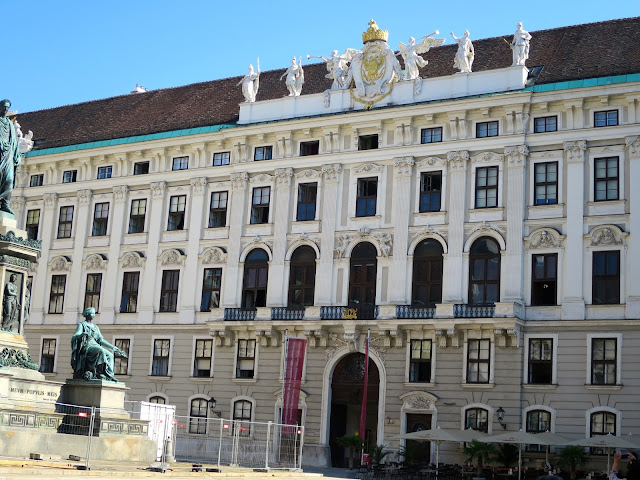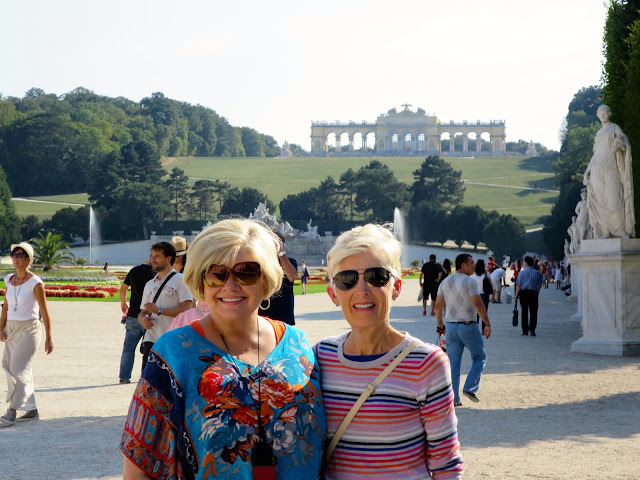Continuing to cruise on the Danube, we arrived at Melk, Austria,
which houses the most famous abbey in Austria.
Melk Abbey was originally a palace built in the 11th century, then it was presented to Benedictine monks.
It is now a prestigious monastery school with more than 700 students.
There were spectacular views from the top.
Unfortunately, there was a major heat wave for most of Europe - 95 degrees for five days straight.
The shade seeker/heat wimp author of this blog is clarifying that it was like 95 degrees in humid NewYork City,
not dry St. George - we're talking humidity along the rivers.
My solution was to carry an umbrella to shelter me from the sun.
As you can see from the pics, I was the only one with this brilliant plan.
I know, I'm a wimp!
The interior with its magnificent frescos was a Baroque extravaganza,
and the library contains around 80,000 medieval manuscripts.
In medieval times, religious leaders were the only ones who could own and read books.
This ivory-carved art treasure dates back almost 1,000 years.
The quaint Austrian village of Melk
After hiking down the many steps from the abbey, Lynn and Clyde stroll through Melk.
Sitting outside the front of a shop,
this display offers passers-by a taste of the local juice and liqueur for a small price.
Here is a pretty view of the twin spires and octagonal dome.
Free tastes of their apricot juice with and without were offered.
After lunch on the boat, some of our group rented bicycles and pedaled along the Danube for 21 miles to Krems.
Roger, Anne and I opted for the scenic views from our longboat.
And scenic views they were!
After we docked at Krems, Roger, Anne and I got off the boat and strolled down the main street.
In that late afternoon sun, this is probably the hottest I was on the whole trip.
We were kind of worried about the cyclists, but they were troopers!
I said to Roger as we walked in the scorching sun, we have to find something cool
to take a pic of before we return to the boat.
How about this fresco?
Dinner on board that night was A Taste of Austria.
Strolling, singing musicians added pleasure to the festive and delicious dinner.
After dessert, our table was invited to tour the galley and see how they put our tasty meals together.
Note the fresh herbs, which were grown on the rooftop and were added
to many of the delicious dishes we enjoyed.
The freshly-baked pastries every morning were to die for!
That evening, when we returned to our rooms, these delicious treats were waiting for us.
Next morning, we docked at Austria's elegant capital city, Vienna.
We were taken on a motor-coach and walking tour to see some of Vienna's highlights.
What a beautiful city!
Roger and I have not been to Vienna before, and we loved the mix of styles of architecture, from Modern to Baroque to Art Nouveau to Rococo to Gothic . . .
Note the swimming pool out on the canal.
We drove by many famous museums and performance halls and churches and government buildings
along the ringstrasse,
along the ringstrasse,
some of which are unfortunately a bit of a blur, but there is much to see in this grand city,
the seat of the world for music and the arts.
The Kunsthistorisches Art Museum
We went on a walking tour of the Hofburg Palace, which was built in the 13th century
and was expanded to house royalty, including the Hapsburgs, as their Winter Palace.
It is the documented seat of government
and is the official residence and workplace of the President of Austria.
We were told wonderful stories of the rich history of Austria.
Pat loves horses (she was a rodeo queen in her day), so she and Clyde left the boat early to stand in line to get tickets to watch the rehearsal of the world-famous Lipizzaner Stallions.
In our tour of the Hapsburg Palace, we passed by the stables and caught a glimpse
of one of the horses in his stall and his rider.
Vienna was once the seat of the Holy Roman Empire, and these are some preserved ruins of that time.
Begun in the 12th Century, Gothic St. Stevens Cathedral is a famous symbol of Vienna.
After we walked through the church, we had free time to wander through the grand streets of Vienna.
I had Roger take some pics of some of the displays in the shop windows.
This is a display made out of marzipan.
Vienna is home of the famous Sachertorte.
We had to purchase for later some candied nuts and candies from this little side shop.
We met back at this sculpture at St. Stevens and boarded our motor-coach to go back to the boat for lunch.
We passed St. Charles Church
Previously, this was the world's tallest Ferris wheel at 212 feet.
The little cars are rented out for weddings and special occasions.
Each of the dishes offered on our Viking cruise were beautifully presented
and usually the portions were not large.
When the menu said Trout Maniere, I thought it would be a dainty little serving!
I was shocked when it came, but it was one of my favorite meals on our trip!
Trout are very popular in Europe, and this was prepared deliciously, so moist and flavorful.
After lunch, Anne, Roger and I went on an optional tour of Schoenbrunn Palace, Summer Palace of the Hopsburgs.
The Hopsburgs basically ruled Europe for 600 years.
In 1276, the family began gaining new territories by marriage.
They sought to retain their massive power through intermarriage between cousins or uncle and niece.
"The best spouse for a Hapsburg is another Hapsburg," went the proverb.
The last of the Spanish line, Charles 11, was disabled from birth, perhaps from a genetic disorder typical in children from siblings, and died.
It's likely the Austrian line ended for the same reasons.
Maria Theresa, mother of Marie Antoinette, certainly did her part to continue the line.
She had 16 children, many who married royalty of other countries.
Bedchamber of Maria Theresa and Franz Stephan
Wife of Franz Joseph 1, Elisabeth (Sisi), was Empress of Austria, Queen of Hungary
and Queen Consort of Croatia and Bohemia.
Considered a beauty, she led a sad and eccentric life.
Her hairdressing of her long, thick hair took over two hours every day,
during which she would study other languages.
It would take the entire day to wash it every two weeks.
The interior rooms were lavish.
This is a painting of a theater performance in the Palace
on the occasion of the marriage of Joseph 11 to Isabella in 1760.
The grounds were huge, with many trees, flowers and fountains.
We all met up for an early dinner that night before we departed
for our Mozart and Strauss (Austrian composers) Concert at the Hofburg Palace.
This was one of my favorite concerts of my life!
Each instrumentalist, each opera singer, the conductor . . .
precise but emotive Perfection!
When they played the Blue Danube Walz at the end, it brought the house down!
They played it again as an encore.
Roger shot this pretty night shot on our ride back to our longboat.
As our Program (Cruise) Director, Rob, called it,
we had a Trifecta Day, going on the city tour in the morning, the Schoenbrunn Palace in the afternoon
and the concert at night.
We love Vienna!















































































































